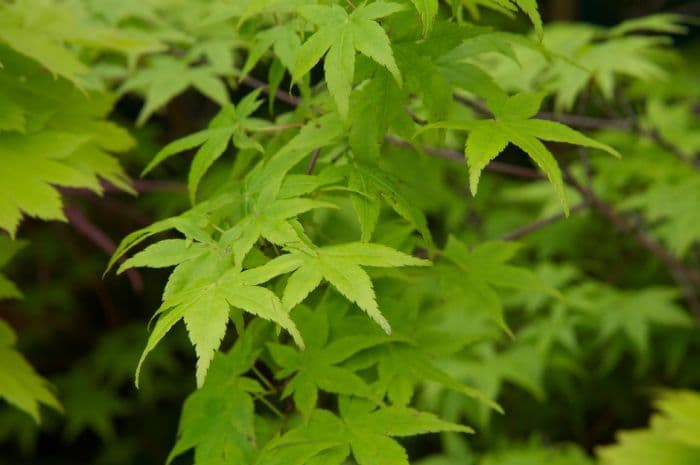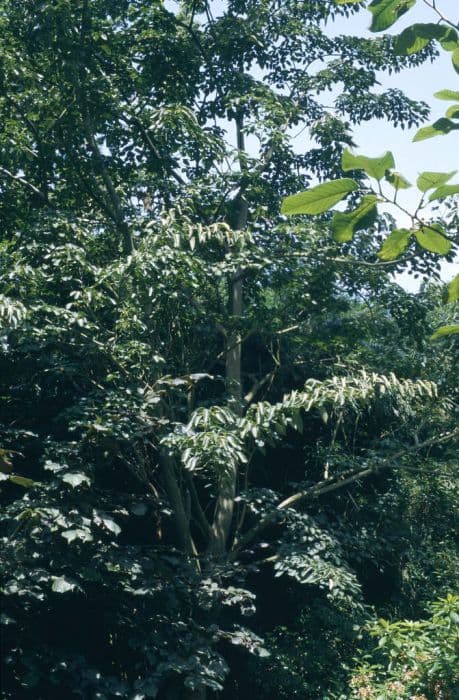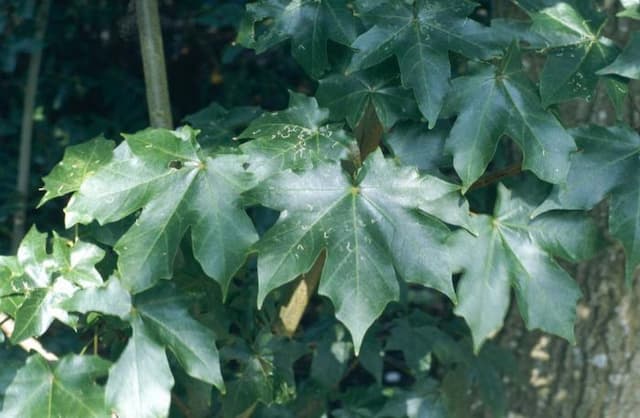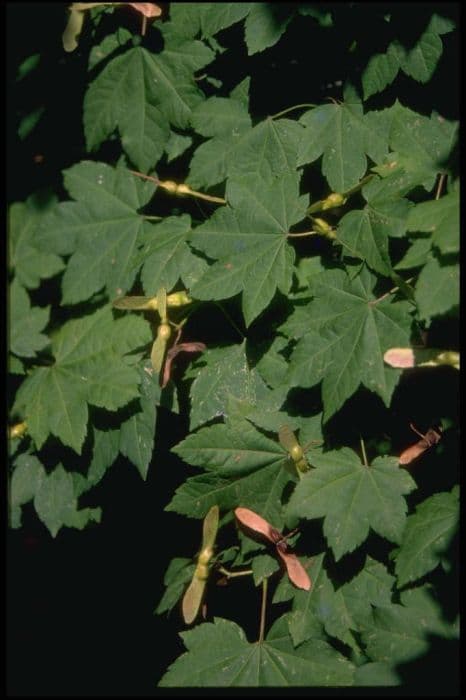Japanese Maple Acer palmatum 'Waka-midori'

ABOUT
Acer palmatum 'Waka-midori', commonly known as the Japanese Maple 'Waka-midori', is a visually stunning variety that impresses with its ornamental features. The plant is known for its striking foliage which changes colors with the seasons. The leaves are palmate, resembling the shape of an open hand with outstretched fingers, and they have a delicate texture that adds a fine, lacy appearance to the plant's silhouette. In spring, the leaves emerge in vibrant shades of green, often with undertones that can range from chartreuse to a deeper emerald hue. As the season progresses, the green becomes more pronounced and lush, creating a refreshing and lively display. The leaf edges may show subtle hints of red or pink, especially when new growth is present. In autumn, the foliage undergoes a dramatic transformation, with the greens giving way to spectacular displays of golden yellows, fiery oranges, and rich reds. The intensity of these fall colors can vary depending on the location and environmental conditions, providing a unique and personalized spectacle each year. The intricate leaf form coupled with the dynamic color changes makes the Japanese Maple 'Waka-midori' a favorite for adding visual interest and elegance to a variety of garden settings, without considering the size of the plant. The overall structure of the plant is typically graceful and spreading, offering a harmonious natural architecture that complements many design styles. Whether used as a focal point or integrated into a mixed planting, this variety of Japanese maple provides exceptional beauty through its distinct and vibrant foliage.
About this plant
 Names
NamesFamily
Sapindaceae
Synonyms
Japanese Maple, Smooth Japanese Maple
Common names
Acer palmatum 'Waka-midori'.
 Toxicity
ToxicityTo humans
Japanese maple is generally not considered toxic to humans. Ingesting parts of this plant typically does not result in poisoning or serious health concerns for humans.
To pets
Japanese maple is also considered non-toxic to pets. It should not cause poisoning or serious health issues if pets ingest parts of this plant. However, it is always recommended to keep an eye on pets to prevent them from eating plants, as individual animals might have sensitivities or allergic reactions.
 Characteristics
CharacteristicsLife cycle
Perennials
Foliage type
Deciduous
Color of leaves
Green
Height
6-8 feet (1.8-2.4 meters)
Spread
5-7 feet (1.5-2.1 meters)
Plant type
Tree
Hardiness zones
5-9
Native area
Japan
Benefits
 General Benefits
General Benefits- Aesthetic Appeal: Adds a vibrant green foliage display to gardens and landscapes.
- Seasonal Interest: Exhibits stunning autumn colors when the leaves change, providing visual interest throughout the seasons.
- Size: Relatively small size makes it suitable for smaller gardens and spaces.
- Canopy Shape: Offers a unique, delicate canopy that can provide light shade and enhance the layered look of garden design.
- Low Maintenance: Generally requires minimal upkeep once established, making it an attractive choice for busy gardeners.
- Cultural Significance: Has a place in traditional Japanese garden design, evoking a sense of tranquility and natural beauty.
- Biodiversity Support: Can provide habitat and food for various bird species and beneficial insects.
 Medical Properties
Medical PropertiesThis plant is not used for medical purposes.
 Air-purifying Qualities
Air-purifying QualitiesThis plant is not specifically known for air purifying qualities.
 Other Uses
Other Uses- Photography Subjects: The Acer palmatum 'Waka-midori', also known as Japanese Maple, provides a stunning subject for photographers, especially in the fall when its leaves turn vivid colors.
- Art Inspiration: Artists often use the striking appearance of Japanese Maple trees as muse for paintings, drawings, and other forms of artwork due to their unique leaf shapes and seasonal color changes.
- Bonsai: Japanese Maple trees are commonly used in the art of bonsai due to their adaptability and appealing aesthetic, making them a favorite among enthusiasts.
- Zen Gardens: The serene and aesthetic qualities of the Japanese Maple make it a suitable choice for creating tranquil Zen gardens.
- Cultural Symbol: In Japan, the Japanese Maple is a symbol of peace and serenity and is often planted in temple gardens and other significant cultural sites.
- Education: Japanese Maples can be used in educational settings to teach about plant biology, horticulture, and the importance of preserving diverse plant species.
- Pattern Design: The leaf shapes and branch patterns of Japanese Maple can inspire design motifs for textiles, wallpaper, and other decorative arts.
- Feng Shui: The Japanese Maple's graceful structure can be used in feng shui practices to harmonize and balance the energy within home gardens and landscapes.
- Film and Theatre Scenery: These trees can be incorporated into set designs for films and stage plays that require a visually-striking or traditionally Japanese background.
- Seasonal Festivals: Branches of Japanese Maple trees, with their autumn foliage, can be used for decorations during seasonal festivals or ceremonies.
Interesting Facts
 Feng Shui
Feng ShuiThe Japanese Maple is not used in Feng Shui practice.
 Zodiac Sign Compitability
Zodiac Sign CompitabilityThe Japanese Maple is not used in astrology practice.
 Plant Symbolism
Plant Symbolism- Beauty and Elegance: The Acer palmatum 'Waka-midori', commonly known as Japanese Maple, symbolizes beauty and elegance with its delicate leaves and graceful growth habit.
- Change and Transformation: The changing colors of the Japanese Maple's leaves from green in the spring and summer, to brilliant reds, oranges, and yellows in the fall, represent the idea of change and transformation.
- Peace and Tranquility: The serene nature of the Japanese Maple, particularly in traditional Japanese gardens, conveys a sense of peace and tranquility.
- Balance and Harmony: With its balanced shape and the harmonious way it fits into various landscapes, the Japanese Maple is often associated with balance and harmony.
- Endurance and Longevity: Japanese Maples can live for many years, symbolizing endurance and longevity.
- Grace under Pressure: The tree's ability to withstand various climates and conditions may symbolize maintaining grace under pressure.
 Water
WaterThe Japanese Maple 'Waka-midori' should be watered deeply once a week, providing about 1.5 to 2 gallons of water for each watering session to ensure the soil remains evenly moist. During hot and dry periods, watering frequency should increase to twice a week, while it should be reduced during rainy seasons to prevent waterlogging. It's important to avoid overhead watering and instead water directly at the base of the tree to prevent fungal diseases.
 Light
LightJapanese Maple 'Waka-midori' thrives in a spot that provides dappled sunlight or partial shade. It's best to protect the tree from harsh afternoon sun which can scorch the leaves. A location that offers morning sunlight with protection from strong midday rays is ideal for this plant.
 Temperature
TemperatureJapanese Maple 'Waka-midori' prefers temperatures ranging between 60 and 80 degrees Fahrenheit. It can survive minimum temperatures down to approximately 15 to 20 degrees Fahrenheit but should be protected from harsh winter winds. The ideal growing conditions are in regions that offer cool to moderate climates without extreme temperature fluctuations.
 Pruning
PruningPruning of Japanese Maple 'Waka-midori' is primarily for shape and structure rather than stimulating growth, so it should be done cautiously. The best time to prune is during the dormant season, late fall to early winter, to avoid sap bleeding. Prune sparingly, focusing on removing any dead or crossing branches and to maintain its natural form.
 Cleaning
CleaningAs needed
 Soil
SoilJapanese Maple thrives in well-drained soil high in organic matter with a pH range of 5.5 to 6.5. A mix of 1/3 peat moss, 1/3 coarse sand, and 1/3 pine bark is often recommended.
 Repotting
RepottingJapanese Maples should be repotted every two to three years to ensure healthy root growth and adequate soil nutrition.
 Humidity & Misting
Humidity & MistingJapanese Maples prefer moderate humidity levels, but they are adaptable to a range of conditions as long as the soil moisture is consistent.
 Suitable locations
Suitable locationsIndoor
Bright light, no direct sun, cool position, well-drained soil.
Outdoor
Partial shade, protect from strong winds, amend soil.
Hardiness zone
5-8 USDA
 Life cycle
Life cycleAcer palmatum 'Waka-midori', commonly known as Japanese Maple 'Waka-midori', begins its life as a seed, which germinates in suitable conditions of moisture and temperature, typically in the spring. The seedling emerges and develops its first set of true leaves, slowly establishing a root system. As the sapling grows, it develops more intricate foliage with the characteristic palmate leaves, and begins to form a woody stem. The tree reaches maturity within several years, wherein it starts to produce flowers followed by winged samaras, or seed pods, which disperse by wind and allow for propagation of new plants. During its mature stage, the Japanese Maple 'Waka-midori' experiences annual cycles of growth in the spring and summer, followed by a brilliant display of fall coloration before shedding its leaves in the winter. The tree can live for many decades, and even over a century, if growing conditions are ideal and it remains unimpeded by disease or environmental stressors.
 Propogation
PropogationPropogation time
Early Spring
The Japanese maple 'Waka-midori' is typically propagated through the technique of grafting, which is the most popular method for this type of tree. Grafting involves joining a piece of the 'Waka-midori' scion wood, which contains the buds of the desired cultivar, to the rootstock of another maple that provides vigor and adaptability to the soil. This is done in late winter or early spring when the tree is still dormant. A common grafting method used for Japanese maples is the 'veneer graft', where a thin slice of bark is cut from the rootstock and a matching piece from the scion wood is placed against the cut surface. The two pieces are then firmly bound together and sealed with grafting tape to prevent desiccation. The grafted union must be kept in a humid environment until the graft has taken, which can typically take a few weeks. Once successful, the grafted plant is gradually acclimatized to outdoor conditions before it is planted out in its final position.








